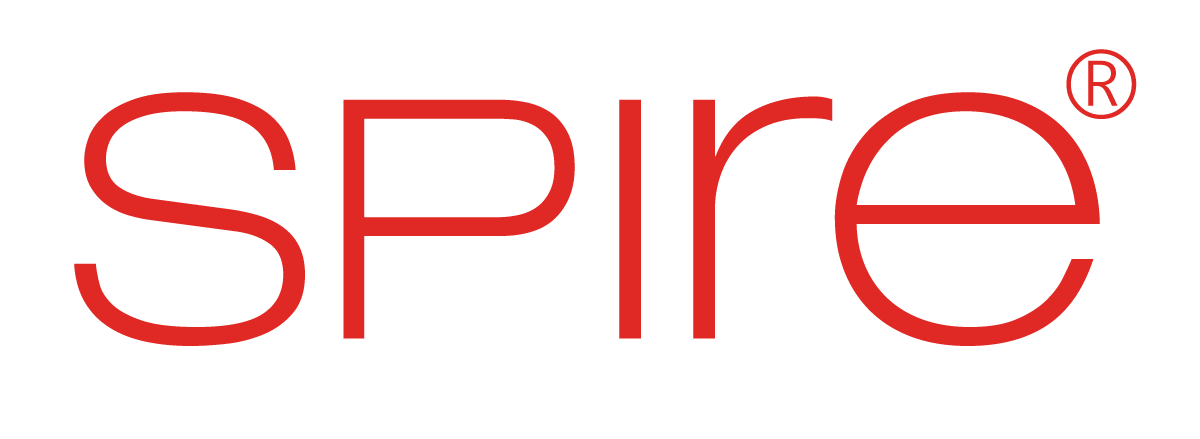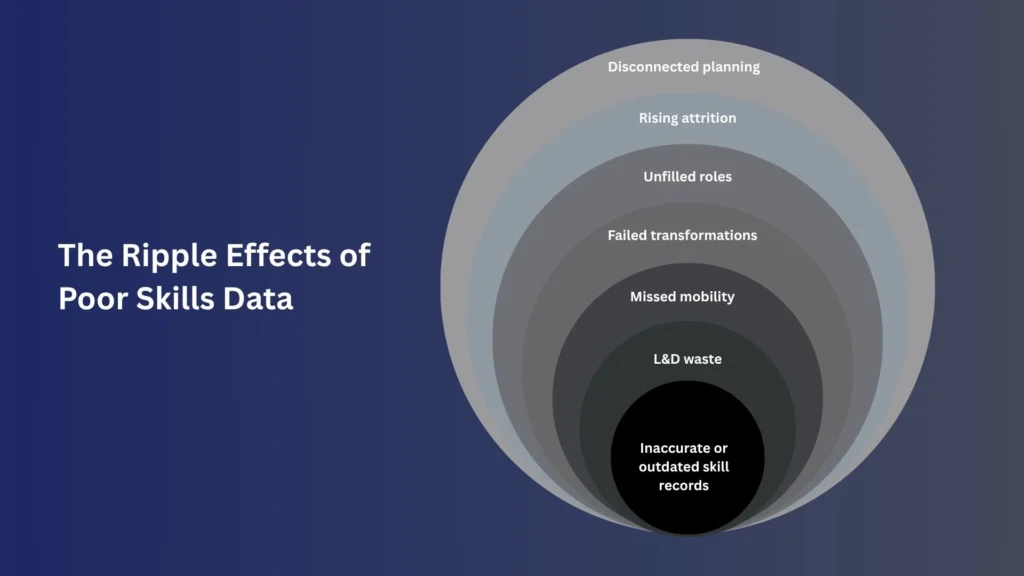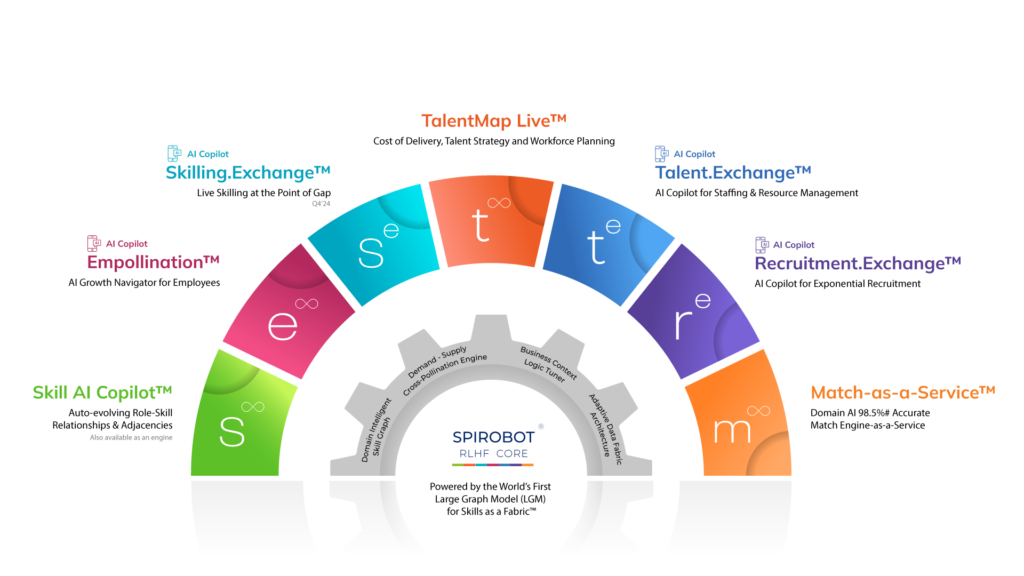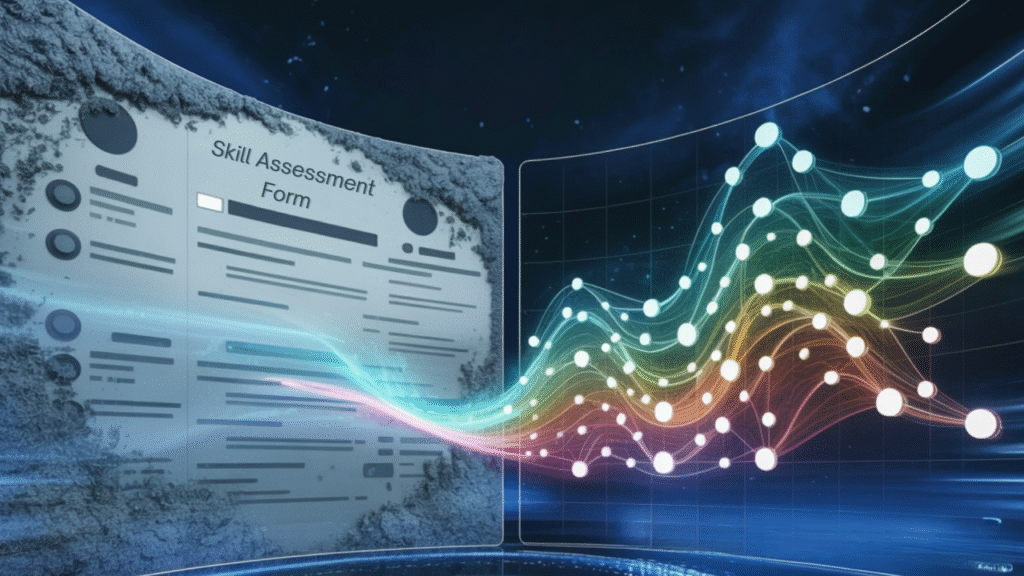The workforce skills gap is one of the most pressing challenges facing enterprises today. Headlines often blame fast-evolving technologies, outdated education systems, or generational shifts. But while these factors contribute, they overlook a deeper structural issue, the lack of reliable, dynamic, and actionable data about workforce skills.
Skills are constantly evolving, but most organizations are working with static inventories, lagging assessments, and manual reporting systems. The result? A persistent misalignment between available talent and business needs, not because skills don’t exist, but because organizations can’t see them clearly enough to act.
In this article, we unpack how the workforce skills gap is fundamentally a data visibility and quality issue and how Domain-intelligent AI and agentic AI, particularly autonomous and context-aware agents, can radically transform how enterprises detect, develop, and deploy talent.
The Skills Gap: What’s Really Broken?
The skills gap is often painted as a pipeline issue; there just aren’t enough qualified workers to fill critical roles. But that narrative oversimplifies the problem. In most organizations, the issue isn’t always a lack of skill in the workforce but a lack of visibility and accuracy in skill data.
At its core, the skills gap is a diagnostic failure. Businesses are trying to solve a talent challenge with uncertain, outdated, or misaligned information.
Let’s break down where things go wrong:
1. Job Descriptions Are Outdated or Misrepresentative
Roles evolve, but job descriptions often don’t. A “data analyst” role from three years ago may now require proficiency in AI model validation, but the internal role card still lists Excel and SQL as core requirements. This disconnect leads to misaligned expectations, poor hires, and overlooked internal talent who actually have the needed skills but aren’t formally recognized for them.
2. Skills Are Trapped in Silos
Most HR systems treat skills as static data points tied to resumes, performance reviews, or L&D completions. But those sources are fragmented and incomplete. A person might be developing a critical skill on a cross-functional project, but if it’s not formally logged in the system, leadership won’t know, and that talent remains invisible for internal mobility or reskilling opportunities.
3. Assessments Are Infrequent and Manual
Traditional skills assessments rely heavily on manager evaluations, self-assessments, or annual reviews. These are subjective, lagging, and prone to bias. In rapidly changing environments, critical decisions like where to hire, whom to promote, or what to train are made based on stale snapshots of capability.
4. One-Dimensional Skill Labels Don’t Tell the Whole Story
Most systems don’t differentiate between skill context or depth. For instance, “cloud architecture” might appear on five resumes, but only one candidate has designed scalable, production-level systems in a regulated industry. Without the context, what the skill was used for, at what level, in what setting organizations risk overestimating or underestimating actual capability.
5. There’s No Unified Source of Truth
Organizations often rely on spreadsheets, disconnected platforms, and tribal knowledge to map workforce capability. Without a centralized, validated, and continuously updated view of talent, it’s nearly impossible to plan for emerging needs, address risk areas, or redeploy people effectively at scale.
This is the crux of the problem: organizations aren’t suffering from the lack of skills; they’re suffering from an inability to see, verify, and act on them. Until this fundamental disconnect is addressed, the skills gap will persist, not as a talent issue, but as a systemic data failure.
Why Skills Data Is So Difficult to Capture Accurately
There are three primary reasons the current approach to skills data doesn’t work:
1. Skills Are Contextual and Role-Dependent
“Project management” means different things to a software engineer vs. a product marketer. Generic labels on resumes or HR tools flatten these nuances. Without understanding how skills manifest in specific roles and business contexts, organizations misclassify or overlook talent entirely.
2. Skills Change Faster Than Systems Can Keep Up
The half-life of many technical skills is now estimated to be 2.5–5 years. Meanwhile, most skills inventories are updated annually (if at all). Learning initiatives are often based on retrospective data, not emerging needs, creating a persistent lag in preparedness.
3. Data Entry Is Manual and Subjective
Most skill records depend on self-reporting, manager assessments, or training completions. This introduces bias and inconsistency, with little to no validation of actual, demonstrated proficiency.
The result? Decisions around hiring, promotion, reskilling, or workforce planning are based on incomplete, inconsistent, and outdated data.
The Real Impact: Business Risks of Poor Skills Data
When skills data is inaccurate, outdated, or fragmented, the consequences ripple far beyond HR; they hit at the very heart of business performance and resilience. Most enterprises are operating with a dangerous blind spot: they don’t truly know what skills exist in their workforce, what’s missing, or where emerging risks are concentrated.
This lack of visibility and reliability in skills data leads to five core business risks:
1. Misdirected L&D Spend and Low ROI on Learning Programs
Companies globally spend billions on upskilling and reskilling. But without a precise understanding of skill baselines or gaps, most L&D programs are based on assumptions rather than validated data. Employees are pushed into one-size-fits-all learning paths that don’t align with current business priorities or their actual skill levels.
Impact:
- Learning fatigue and disengagement
- Low completion and application rates
- Wasted budget on redundant or irrelevant training
- No measurable skill uplift to inform workforce planning
2. Inefficient Talent Allocation and Missed Internal Mobility
When skills aren’t visible, employees often end up underutilized or misassigned. A data analyst with growing cloud experience may be overlooked for a critical cloud migration project simply because that skill isn’t reflected in any official record. Similarly, high-potential employees are often missed for stretch roles or internal moves.
Impact:
- External hiring for roles that could be filled internally
- Slower time-to-staff for strategic initiatives
- Higher risk of attrition among overlooked talent
- Reduced agility in responding to business shifts
3. Delayed or Failed Digital Transformation Efforts
Modern business transformation relies on precise workforce readiness, especially for digital initiatives. Whether it’s moving to AI-enabled operations, deploying a new ERP, or pivoting to cloud-native systems, success depends on knowing: Do we have the right skills in place to execute?
When skills data is unreliable or outdated, transformation leaders can’t forecast capability gaps, assign internal talent confidently, or determine where external hiring is truly needed.
Impact:
- Delayed project timelines
- Greater dependence on contractors and consultants
- Higher transformation costs
- Increased risk of failure due to mismatched teams
4. Inability to Plan for Future Talent Needs
Strategic workforce planning hinges on two capabilities: visibility into current skills and forecasting future demand. Poor skills data sabotages both. Organizations either overhire (as a hedge against uncertainty) or underhire and end up with last-minute talent gaps they can’t fill quickly.
Impact:
- Increased recruiting costs
- Business units operating below capacity
- Disconnected talent and business strategy
- Difficulty building future-ready teams
5. High Attrition and Low Engagement from Skill Misalignment
Employees today expect clear growth pathways and meaningful development. When organizations can’t identify and align their skills with evolving opportunities or worse, assign them to roles that don’t reflect their strengths and engagement plummets. Many leave not because they lack skills, but because their skills aren’t recognized or used.
Impact:
- High voluntary attrition, especially among top performers
- Decline in employee trust and morale
- Increased onboarding and backfill costs
- Missed opportunity to build internal capability over time
All these consequences point to one conclusion: poor skills data undermines strategic execution. Whether you’re trying to launch a new product, expand into a new market, digitize customer service, or comply with emerging regulations, your ability to deliver rests on whether your workforce is ready.
And without accurate, validated, and up-to-date skills intelligence, that readiness remains unknown and unmanageable.
How AI Fixes the Skills Gap: Moving from Static to Smart
Fixing the workforce skills gap isn’t just a matter of automation or digital record-keeping; it requires an intelligent system that understands how roles, skills, and business contexts interact dynamically over time. This is where Domain-intelligent AI plays a transformative role.
Unlike generic automation or statistical models, domain-intelligent AI systems are designed to understand the nuances of enterprise functions, roles, and industry-specific contexts. This allows them to go beyond surface-level data and deliver contextual, validated, and actionable insights around workforce skills.
From Static Records to Living Intelligence
|
Traditional Approach |
With Domain-Intelligent AI |
|
Annual skill audits |
Continuous validation |
|
Self-assessments |
Evidence from real work |
|
Flat job descriptions |
Context-aware role modeling |
|
Siloed data |
Unified, evolving skills graph |
Here’s how domain-intelligent AI addresses the core problems:
1. Dynamic Role-Skill Mapping Based on Context, Not Keywords
Static role definitions quickly become obsolete. Spire.AI’s Large Graph Model (LGM) for Skills continuously updates the skill expectations of a role, not based on generic market trends or keyword parsing but by interpreting how that role functions within your business context. Powered by Domain-intelligent AI, the LGM for Skills distinguishes between the nuanced skill requirements of the same role across different environments. For instance, a “solutions architect” in a telecom enterprise won’t be mapped the same way as one in fintech or healthcare.
Why this matters:
Organizations gain a real-time, contextualized understanding of what each role truly requires now and in the near future.
2. Skill Recognition Based on Work Artifacts and Performance Outcomes
Rather than relying on outdated self-assessments or manager inputs, Domain-intelligent AI interprets actual work artifacts – project data, team assignments, delivery milestones, business outcomes to understand which skills are being exercised, to what extent, and in what context.
Why this matters:
Skills are recognized based on demonstrated proficiency in the flow of work, not just course completions or declarations.
3. Live Validation of Skills in Business Context
Domain-intelligent AI doesn’t treat skills as binary (you have it or you don’t). Instead, it validates them based on how they are applied across different business situations. For example, “problem-solving” in an enterprise sales context is different from “problem-solving” in engineering operations. The system understands these variations and assigns weight accordingly.
Why this matters:
You get context-sensitive skill validation that reflects actual business readiness, not abstract competencies.
4. Continuously Updated Skills Graph
At the heart of this approach is a living skills graph – a dynamic model that maps relationships between roles, skills, responsibilities, business functions, and outcomes. Domain-intelligent AI keeps this graph continuously updated based on live enterprise signals, so it reflects the current state and direction of your organization’s capability landscape.
Why this matters:
You can identify emerging gaps, redeploy underutilized talent, and guide skilling initiatives with real-time precision.
5. Actionable Workforce Intelligence Without Guesswork
Because Domain-intelligent AI is grounded in the logic and structure of your specific business domain, the insights it generates are immediately usable. Whether you’re planning a transformation program, assessing internal talent for a new vertical, or launching a reskilling initiative, the system tells you exactly where to focus with no guesswork or manual analysis.
Why this matters:
Every workforce decision, from hiring to skilling to promotion is powered by trustworthy, explainable insights rooted in your business reality.
The New Operating Model: Skills as a Living Asset
Moving from fragmented snapshots to a living, intelligent skills system marks a radical shift. It allows organizations to:
- Forecast skills demand vs. supply more accurately
- Build resilient talent pipelines with internal mobility and upskilling
- Support skills-based hiring and promotions
- Execute on strategic workforce planning with confidence
But to realize this shift, organizations need more than AI capabilities; they need an agentic framework that can autonomously process, interpret, and act on skills intelligence.
Where Spire.AI Fits In: Turning Skills Chaos into Clarity
For most enterprises, the challenge isn’t the absence of skilled talent but the absence of clarity around skills. Skills data is scattered across systems, locked in outdated records, and divorced from business context. This results in missed opportunities, stalled planning, and misaligned investments in talent.
Spire.AI exists to solve this problem at its root. Built on 18 years of deep-tech and enterprise domain expertise, Spire.AI transforms fragmented, stale, and shallow skills data into live, validated, and business-aligned intelligence. It doesn’t just digitize the skills record; it reinvents how enterprises understand and operationalize workforce capability.
Here’s how:
1. A Domain-Intelligent Foundation Built for Enterprise Complexity
Spire.AI’s core architecture is built around Domain-intelligent AI, a solution trained not on internet-scale randomness, but on the structure, logic, and interdependencies of real enterprise roles and workflows. That means it understands that the same skill can play out differently depending on the business unit, industry, level of seniority, or transformation stage.
Rather than treat roles and skills generically, Spire.AI builds a high-fidelity model of your organization’s capability landscape, rooted in your operational context.
2. A Living Skills Graph: Continuously Updated, Always Contextual
At the center of Spire.AI’s platform is its proprietary Large Graph Model (LGM) for Skills a dynamic network that maps relationships between:
- Skills and sub-skills
- Roles and responsibilities
- Projects and outcomes
- Business functions and goals
This graph updates continuously based on enterprise signals, performance data, organizational changes, and real-world usage. It doesn’t require manual intervention or static tagging; it evolves organically as your business evolves.
This ensures that your view of workforce capability is always current, context-aware, and strategically actionable.
3. Agent Sigma: The Autonomous Copilot for Talent Decisions
At the operational level, Spire.AI introduces Agent Sigma, an autonomous agentic AI that serves as your talent co-pilot across the entire talent lifecycle.
Agent Sigma is not a chatbot or dashboard, it’s an autonomous decision-making layer that continuously:
- Interprets live workforce signals (e.g., project data, team performance, skill application)
- Profiles roles and people in real time
- Validates skill proficiency based on context and outcomes
- Recommends actions like internal matches, skilling journeys, or deployment decisions with business impact in mind
The result? Your HR, L&D, and business teams operate with high-confidence clarity, backed by a system that understands not just skills, but how those skills power business objectives.
4. From Insight to Action: A Closed Loop for Skills Intelligence
Unlike fragmented HRIS systems or standalone skilling platforms, Spire.AI creates a closed-loop system:
- Skill data is captured dynamically, not declared
- Validation happens through usage and outcomes, not opinions
- Intelligence is delivered continuously, not quarterly
- Recommendations are contextualized, not templated
This means workforce decisions whether you’re planning a reorganization, ramping up digital capabilities, or launching internal mobility programs are backed by trusted, live skills intelligence.
5. Strategic Value Across the Talent Lifecycle
Spire.AI enables your organization to:
- Accelerate skills-based hiring with contextual candidate-role matching
- Unlock internal mobility by surfacing hidden or emerging talent
- De-risk transformation programs by validating readiness at scale
- Optimize L&D spend through precision-targeted skilling
- Build resilient workforce strategies grounded in live capability insights
In short, Spire.AI doesn’t just help you see the skills gap; it helps you close it proactively and continuously.
The Skills Gap Isn’t Going Away, But It Can Be Solved
If your organization is struggling with misaligned talent, stalled transformation, or low internal mobility, the root cause may not be a lack of skill; but a lack of clarity.
The workforce skills gap is a data problem first and a strategic risk second. The good news? Spire.AI offers a path forward. By helping shift from static inventories to dynamic, validated, and context-aware intelligence, enterprises can bridge the gap, not just measure it.
With agentic AI platforms like Spire.AI, skills become a living asset, not a liability. And your workforce becomes a strategic engine for continuity and competitive advantage.







